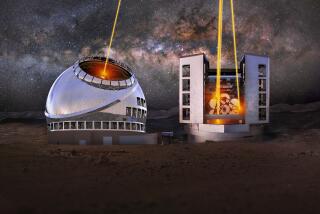The next frontier: energy
Roughly 240,000 miles above this blue rock is a metal plaque bearing the words, “Here men from the planet Earth first set foot upon the moon July 1969, A.D. We came in peace for all mankind.” Today, as we memorialize the launch of the mission that put it there 40 years ago, we should also remember the mission’s central lesson -- that given the political will, there are few things this nation cannot achieve.
Proposing to send human beings to the moon and back by the end of the decade, as President John F. Kennedy did in 1961, seemed as unlikely a prospect then as, say, weaning the United States off foreign oil by 2020 is today. Fortunately for Kennedy, he had fear on his side. NASA had been created in 1958 in response to the launch of the Sputnik satellite by the Soviet Union, which led to the terrifying realization that superior U.S. air power could be nullified by superior Soviet missile technology. NASA was technically in charge of civilian space programs, and the Advanced Research Projects Agency handled military programs, but it seemed to Cold Warriors on both sides that the winner of the moon race would also be the winner of the quest to militarize space.
As it turned out, the U.S. was the winner in consumer technology as well. Government-sponsored research and development into manned spaceflight led to thousands of new discoveries and products. Baby formula, springy athletic shoes, fireproof materials and cordless tools are among the results (but not, surprisingly, Tang, which was developed independently by General Foods in 1957).
The lessons of 1969 are not lost on President Obama, who referred to the moon landing in a speech before the National Academy of Sciences in April. He was promoting an ambition less lofty than Kennedy’s but a good deal more pressing in terms of humanity’s future -- replacing fossil fuels with cleaner sources of energy, what Obama called “this generation’s great project.”
As Obama acknowledged, this time around there is no Sputnik moment to rally political and popular support. Instead, there are computer-generated climate models of questionable reliability, glacier studies in far-flung places, killer heat waves on the other side of the world in Australia, alarming charts on the increase in average global temperatures to date and other evidence of interest to eggheads. It’s convincing stuff to those open to new ideas, but it hardly focuses the mind like the threat of a Soviet ICBM targeted at downtown Los Angeles.
It’s worth remembering that the space race brought with it a renaissance in American education and scientific research that paid dividends above and beyond the propaganda value of beating the Soviets to the moon or the spiritual value of witnessing the smallness and fragility of Earth as seen from another world. For all the grumbling over the economic costs of fighting climate change, it will have similar benefits, not the least of which will be leaving a planet for our children that’s as green as the one we inherited from our parents.






